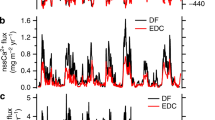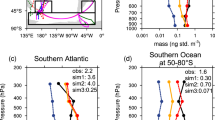Abstract
The atmosphere overlying the ocean is very sensitive—physically, chemically and climatically—to air pollution. Given that clouds over the ocean are of great climatic significance, and that sulphate aerosols seem to be an important control on marine cloud formation1, anthropogenic inputs of sulphate to the marine atmosphere could exert an important influence on climate. Recently, sulphur emissions from fossil fuel burning by international shipping have been geographically characterized2, indicating that ship sulphur emissions nearly equal the natural sulphur flux from ocean to atmosphere in many areas3. Here we use a global chemical transport model to show that these ship emissions can be a dominant contributor to atmospheric sulphur dioxide concentrations over much of the world's oceans and in several coastal regions. The ship emissions also contribute significantly to atmospheric non-seasalt sulphate concentrations over Northern Hemisphere ocean regions and parts of the Southern Pacific Ocean, and indirect radiative forcing due to ship-emitted particulate matter (sulphate plus organic material) is estimated to contribute a substantial fraction to the anthropogenic perturbation of the Earth's radiation budget. The quantification of emissions from international shipping forces a re-evaluation of our present understanding of sulphur cycling and radiative forcing over the ocean.
This is a preview of subscription content, access via your institution
Access options
Subscribe to this journal
Receive 51 print issues and online access
$199.00 per year
only $3.90 per issue
Buy this article
- Purchase on Springer Link
- Instant access to full article PDF
Prices may be subject to local taxes which are calculated during checkout



Similar content being viewed by others
References
Charlson, R. J., Lovelock, J. E., Andreae, M. O. & Warren, S. G. Oceanic phytoplankton, atmospheric sulphur, cloud albedo, and climate. Nature 336, 655–661 (1987).
Corbett, J. J. & Fischbeck, P. S. Emissions from ships. Science 278, 823–824 (1997).
Corbett, J. J., Firschbeck, P. S. & Pandis, S. N. Global nitrogen and sulfur emissions inventories for oceangoing ships. J. Geophys. Res. 104, 3457–3470 (1999).
Benkovitz, C. M. et al. Global gridded inventories of anthropogenic emissions of sulfur and nitrogen. J. Geophys. Res. 101, 29239–29253 (1996).
Kasibhatla, P., Chameides, W. L. & St John, J. Athree-dimensional global model investigation of seasonal variations in the atmospheric burden of anthropogenic sulfate aerosols. J. Geophys. Res. 102, 3737–3759 (1997).
Pham, M., Muller, J.-F., Brasseur, G. P., Granier, C. & Mégie, G. Athree-dimensional study of the tropospheric sulfur cycle. J. Geophys. Res. 100, 26061–26092 (1995).
Benkovitz, C. M. et al. Sulfate over the North Atlantic and adjacent continental regions: evaluation for October and November 1986 using a three-dimensional model driven by observation-derived meteorology. J. Geophys. Res. 99, 20725–20756 (1994).
Capaldo, K. & Pandis, S. Dimethylsulfide chemistry in the remote marine atmosphere: Evaluation and sensitivity analysis of available mechanisms. J. Geophys. Res. 102, 23251–23267 (1997).
Davison, B. & Hewitt, C. N. Elucidation of the troposphere reactions of biogenic sulfur species from a field measurement campaign in NW Scotland. Chemosphere 28, 543–557 (1994).
Davison, B. et al. Dimethyl sulfide, methane sulfonic acid and physiochemical aerosol properties in Atlantic air from the United Kingdom in Halley Bay. J. Geophys. Res. 101, 22855–22867 (1996).
De Bruyn, W. J., Bates, T. S., Cainey, J. M. & Saltzman, E. S. Shipboard measurements of dimethyls sulfide and SO2 southwest of Tasmania during the first Aerosol Characterization Experiment (ACE 1). J. Geophys. Res. 103, 16703–16711 (1998).
Ferek, R. J. et al. Dimethyl sulfide in the Arctic atmosphere. J. Geophys. Res. 100, 26093–26104 (1995).
Pio, C. A., Cerqueira, M. A., Castro, L. M. & Salgueiro, M. L. Sulphur and nitrogen compounds in variable marine/continental air masses at the southwest European coast. Atmos. Environ. 30, 3115–3127 (1996).
Talbot, R. W. et al. Chemical characteristics of continental outflow from Asia to the troposphere over the western Pacific Ocean during February–March 1994: Results from PEM-West B. J. Geophys. Res. 102, 28255–28274 (1997).
Thornton, D. C. & Bandy, A. R. Sulfur dioxide and dimethyl sulfide in the central Pacific troposphere. J. Atmos. Chem. 17, 1–13 (1993).
Bandy, A. R., Scott, D. L., Blomquist, B. W., Chen, S. M. & Thornton, D. C. Low yields of SO2 from dimethyl sulfide oxidation in the marine boundary layer. Geophys. Res. Lett. 19, 1125–1127 (1992).
Hertel, O., Christensen, J. & Hov, O. Modelling of the end products of the chemical decomposition of DMS in the marine boundary layer. Atmos. Environ. 28, 2431–2449 (1994).
Saltelli, A. & Hjorth, J. Uncertainty and sensitivity analyses of OH-initiated dimethyl sulphide (DMS) oxidation kinetics. J. Atmos. Chem. 21, 187–221 (1995).
Suhre, K. et al. Physico-chemical modeling of the first Aerosol Characterization Experiment (ACE 1) Lagrangian B1: A moving column approach. J. Geophys. Res. 103, 16433–16455 (1998).
Carlton, J. S., Wright, A. A. & Coker, R. J. Marine Exhaust Emissions—A Regional Survey of the English Channel (Marine Management (Holdings) Ltd, London, (1994).
Port of Los Angeles, PortofLongBeac, Dames & Moore, MorrisonandFoerste Control of Ship Emission in the South Coast Air Basin: Assessment of the Proposed Federal Implementation Plan Ship Fee Emission Fee Program (Port of Los Angeles, Los Angeles, California, (1994).
Nonroad Engine and Vehicle Emission Study (US Environmental Protection Agency, Washington DC, (1991).
Radke, L. F., Coakley, J. A. J & King, M. D. Direct and remote sensing observations of the effects of ships on clouds. Science 246, 1146–1149 (1989).
King, M. D., Radke, L. F. & Hobbs, P. V. Optical properties of marine stratocumulus clouds modified by ships. J. Geophys. Res. 98, 2729–2739 (1993).
Ferek, R. J., Hegg, D. A., Hobbs, P. V., Durkee, P. & Nielsen, K. Measurements of ship-induced tracks in clouds off the Washington coast. J. Geophys. Res. 103, 23199–23206 (1998).
Carlton, J. S. et al. Marine Exhaust Emissions Research Programme (Lloyd's Register Engineering Services, London, (1995).
Lyyranen, J., Jokiniemi, J., Kauppinen, E., Joutsensaari, J. & Auvinen, A. Particle formation in medium speed diesel engines operating with heavy fuel oils. J. Aerosol Sci. 29, S1003–S1004 (1998).
Seinfeld, J. H. & Pandis, S. N. Atmospheric Chemistry and Physics: From Air Pollution to Climate Change (Wiley & Sons, New York, (1998).
IPCC Radiative Forcing of Climate Change. The 1994 Report of the Scientific Assessment Working Group of the Intergovernmental Panel on Climate Change (IPCC) (Cambridge Univ. Press, (1995).
Acknowledgements
This work was supported by the US NSF and the NOAA Office of Global Programs.
Author information
Authors and Affiliations
Corresponding author
Rights and permissions
About this article
Cite this article
Capaldo, K., Corbett, J., Kasibhatla, P. et al. Effects of ship emissions on sulphur cycling and radiative climate forcing over the ocean. Nature 400, 743–746 (1999). https://doi.org/10.1038/23438
Received:
Accepted:
Issue Date:
DOI: https://doi.org/10.1038/23438
This article is cited by
-
Temporal variations, transport, and regional impacts of atmospheric aerosol and acid gases close to an oil and gas trading hub
International Journal of Environmental Science and Technology (2023)
-
Techno-economic analysis of renewable fuels for ships carrying bulk cargo in Europe
Nature Energy (2022)
-
Trade-linked shipping CO2 emissions
Nature Climate Change (2021)
-
The impact of scrubber discharge on the water quality in estuaries and ports
Environmental Sciences Europe (2020)
-
Environmental and economic analysis of waste management scenarios for a warship in life cycle perspective
Journal of Material Cycles and Waste Management (2020)
Comments
By submitting a comment you agree to abide by our Terms and Community Guidelines. If you find something abusive or that does not comply with our terms or guidelines please flag it as inappropriate.



